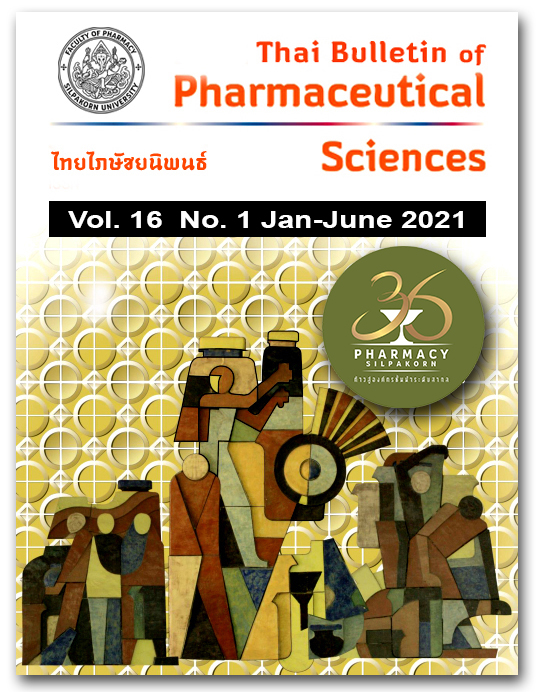EFFICIENCY OF LINE@ APPLICATION TOWARDS DRUG – INFORMATION QUESTION – ANSWERING SYSTEM AT JAINAD NARENDRA HOSPITAL
DOI:
https://doi.org/10.69598/tbps.16.1.45-60Keywords:
Automatic drug answering system, Drug information service, Line@ ApplicationAbstract
The aim of this study was to develop and evaluate the efficiency of the Line@ Application for its potential use as a drug-information system that could provide an answering service for questions relating to medicine, in Jainad Narendra Hospital. Phase 1 involved the development of a tool to perform this task through group discussions and brainstorming sessions of 5 specially selected people. Example questions about medicine were selected for use in the study, and a process was developed using Line@ Application to create an automatic drug-answering service. Phase II was a quasi-experimental study. Line@ Application was trialled in a live setting as a drug-information question-answering system from 1 August 2019 to 30 October 2019. Data were collected by tracking participants’ use of the system, with the results presented onscreen. These results were combined with the results of an online questionnaire completed by participants in the trial. Data were analyzed by using descriptive statistics. The results found 3 types of questions selected into the study were: 1) Dosage and administration - 62 questions. 2) Y-site compatibility - 21 questions, and 3) Stability and storage - 15 questions. Users had to use predetermined keywords in order to carry out a search. The results showed that of the questions selected for use in the study and included in the Line@ Application database, 51 were asked by the participants. 32 online questionnaires were completed and returned (64 %). With respect to its service capacity, Line@ Application was able to provide answers within 1 minute (92.16 %). This represents a reduction from the usual waiting time of 7 minutes. The answers provided were all correct (100 %). The application proved to be capable of meeting the demands of the users, reducing the redundant process of pharmacists that occurred in the old process. From the perspective of usability, the participants reported that they were satisfied with Line@ Application (96.87 %). They thought the Line@ Application was easy to use (100 %) and that it provided them with useful drug information (100 %). It clearly fulfilled the users’ expectations. The automatic drug-answering service through Line@ Application should be further developed for use in the provincial network of drug information services.
References
The Association of Hospital Pharmacy (Thailand). Standards for Hospital Pharmacy Professional Practice (2013 – 2017) [Internet]. 2017 [Cited 2018 Mar 31]. Available from: https://www.thaihp.org/index.php?lang=th&option=home (in Thai)
Chanakit T, Kumpalum D, Kunwaradisai N, Swatwongchai Y, Ragsawong N. Characteristics of drug information service in Thailand. Thai Pharm Health Sci J. 2009;4(4):490-499. (in Thai)
Chanakit T. Drug Information Service (in Thai). Ubon Rajathanee: Ubon Rajathanee press; 2012. (in Thai)
©LINE Corporation. How to use LINE@ [Internet]. 2011 [Cited 2018 Jun 24]. Available from: http://at.lineapp.me/tips-tricks/ (in Thai)
Pimsiripanich S. Build a new business world with Line@. Bangkok: You2morrow; 2017. (in Thai)
Womack JP, Jones DT, Roos D. The machine that changed the world: The story of lean production. New York: Rawson and Associates; 1990.
Womack JP, Jones DT. Beyond Toyota: how to root out waste and pursue perfection. Harv Bus Rev. 1996;74(5):140-53.
Stamatis DH. Six sigma and beyond: foundations of excellent performance. New York: St. Lucie Press; 2002.
Nielsen J. Usability 101: Introduction to usability [Internet]. 2012 [cited 2018 Aug 13]. Available from: https://www.nngroup.com/articles/usability-101-introduction-to-usability/
Patramontree U, Raungpaka V. Usability Testing in Internal Auditing: Case Study of a Project Management Software. Kasetsart Applied Business J. 2009;3(1):11-22. (in Thai)
Sangjam P, Lucksanawongsri P, Chaiyaporn K, Tangkiatkumjai M, Treesak C. Telephone-based drug information service: a private hospital experience. SWU J Pharm Sci. 2005;10(1):48-57. (in Thai)
Supakul S, Vientong P. Development of an automatic question-answering system for drug information center, Faculty of Pharmacy, Chiang Mai University. Thai J Hosp Pharm. 2015;25(1):9-18. (in Thai)
Sirisamut T. 10 years drug information service, Siriraj. Thai Pharm Health Sci J. 2010;5(1):95-98. (in Thai)
Tepjit S. Evaluation Lean Six Sigma Implementation using System Dynamic Modeling: Case study in the Hospital [Dissertation]. Bangkok: King Mongkut’s Institute of Technology North Bangkok; 2006. (in Thai)
Worawong W. The Manufacturing Development Process of Cytotoxic Drug Admixtures at Queen Sirikit Naval Hospital, Naval Medical Department, Using Lean Six Sigma Methodologies [Dissertation] Nonthaburi: Sukhothaithammathirat University; 2013. (in Thai)
Fuengdenkhajon N. Responsiveness Improvement in Dental Service Industry by Lean Six Sigma Approach: a Case Study of Special Dental Service Clinic [Dissertation] Bangkok: Chulalongkorn University; 2004. (in Thai)
Udompan W, Khonchoho V, Chimphlee W, Longpradit P. Incident reduction procedure by Lean Six Sigma methodology of Basel II system. Suan Dusit Grad Sch Acad J. 2015;11(3):53-61. (in Thai)
Piriyakul M, Piriyakul R, Chuacharoen O, Boonyoung M, Piriyakul P, Piriyakul I. Factors effecting intention to reuse internet transaction. Lanna Acad J. 2015;1(1):1-21. (in Thai)
Chaveesuk S, Vongjaturapat S. Unified theory of acceptance and use of technology. KMITL Inf Technol J. 2012;1(1):2-22. (in Thai)
Davis FD, Bagozzi PR, Warshaw P. User acceptance of computer technology: a comparison of two theoretical models. Manage Sci. 1989;35(8):982-1003.
Downloads
Published
How to Cite
Issue
Section
License
All articles published and information contained in this journal such as text, graphics, logos and images is copyrighted by and proprietary to the Thai Bulletin of Pharmaceutical Sciences, and may not be reproduced in whole or in part by persons, organizations, or corporations other than the Thai Bulletin of Pharmaceutical Sciences and the authors without prior written permission.



